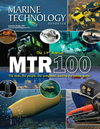
Page 35: of Marine Technology Magazine (September 2024)
Read this page in Pdf, Flash or Html5 edition of September 2024 Marine Technology Magazine
Aerial view from Signal
Hill across Gibbet Hill with the Queen’s Battery
Barracks and the Narrows
The spaces and places into St John’s Harbor.
of Newfoundland and
Labrador’s maritime, o? shore and subsea industries.
By Celia Konowe he maritime industry in Newfoundland and Labrador (NL) is unique—versa- tile, adaptable, collaborative and community-focused. This is not only due to the
North Atlantic’s proximity, providing some of the most challenging and harsh
T ocean conditions, but also to centuries of sea living by determined and innovative people who created spaces that encourage synergy and minimize barriers. As a result, the province is home to state-of-the-art facilities supporting research, simulation and training, and innovation. Together, they are the spaces and places that help NL maritime science and technology evolve and thrive.
Atop the Rock
Known colloquially as The Rock, NL has rugged geology and sticks out into the North At- lantic, which offers dynamic and unpredictable weather system thanks to the Gulf Stream and the Labrador current colliding offshore. Water depths range from 80 to more than 3,800 me- ters at the infamous Titanic wreck. With a population of just over 500,000, NL has centuries of living by and depending on the sea, explained the Hon. Andrew Parsons, Minister of In- dustry, Energy and Technology. Fishery was the original backbone of the economy, although that has shifted to re? ect the blue economy and a diverse array of maritime challenges.
The reason that NL developed a unique array of maritime expertise is simple: they had to. “There were opportunities to grow it here because a lot of technology that was available—or not available—didn’t re? ect, or couldn’t deal with [our unique] operational challenges, the reality of our conditions: this mixture of weather, ice, sea state and isolation, as well as the variability and quick change in the weather patterns here,” explained Chris Hearn, director of the Centre for Marine Simulation at Memorial University of Newfoundland (MUN). “When you live in a harsh environment, you have limited resources and you’re isolated, you have to be really good at coming up with solutions and problem solving on demand,” added
Meagan Kay-Fowlow, president of the Co. Innovation Centre. “You don’t have a choice.”
The provincial government, Hearn said, recognized the need for and bene? t of innovation early on. “We are truly nimble, we are adaptive, and we want people to come here,” Parsons emphasized. “[We’re] surrounded by an amazing team of people that are interested and
LID committed to economic development and opportunity. We’re very proud of our responsive- www.marinetechnologynews.com 35
MTR #7 (34-49).indd 35 10/3/2024 12:13:35 PM

 34
34

 36
36
